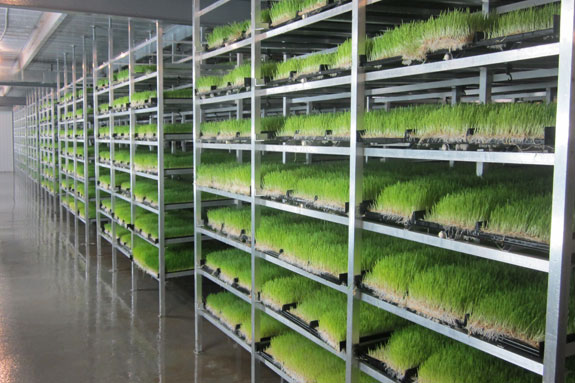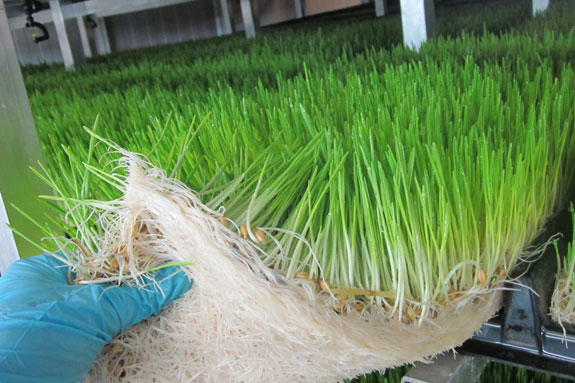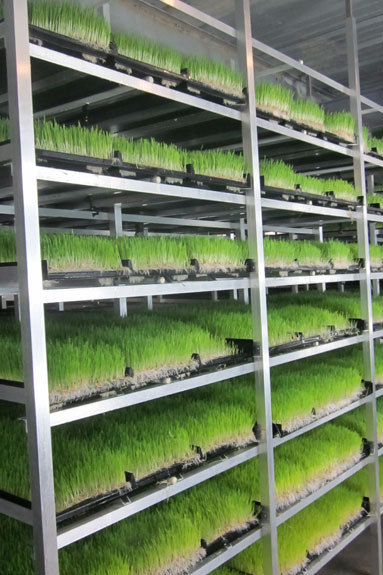This article was #1 of the Top 25 most well-read articles on www.progressivedairy.com in 2013. It was published in the March 21, 2013 Extra e-newsletter. Click here for the full list of the Top 25. This article featured Calvin Nash of Weston, Idaho, and west Texas electrical engineer and former dairyman Tom White. Nash and White discussed their success with hydroponic sprout fodder systems.
Though Nash’s herd saw a drop in milk production, he reported a net gain of $10,000 a month, while White claims the system will pay for itself in less than five years.
Along with being the best-read article of the year, this piece drew plenty of online comments. Readers asked follow-up questions about the labor of growing the sprouts and the challenges involved in offering it to their cows. Read those .
A follow-up article, " Experts remain leery on feeding sprouts, while farmers using the system are pleased " addresses these questions and provides new developments in sprout fodder systems. PD
ARTICLE:

With drought conditions and high feed prices creating havoc for many dairies, some producers are finding an innovative and cost-effective solution with sprout fodder.
Calvin Nash has a Jersey farm he operates with his wife, Julie, near Weston, Idaho. He started growing and feeding barley sprout fodder to his herd in December 2012.
His advice to fellow dairy farmers considering a hydroponic unit to grow sprouting fodder for dairy cows is simple: “Don’t believe the nutritionists, this actually does work!”
The hydroponic units are typically loaded with barley seeds, and within about six days, there is eight inches of luscious cattle feed that is high in protein. Other seeds such as alfalfa do work, but barley is known to quickly produce the highest-quality fodder.

Nash purchases all the feed for his 200-cow dairy, which is located in the high desert. He estimates he was losing about $35,000 a month, and the lack of affordable hay was a huge problem.
“I couldn’t afford any other option,” Nash says.
He switched his herd overnight from one ration (grain corn, hay, straw, liquid whey and protein) to the new sprout ration (35 lbs fodder, 25 lbs straw, .20 lb urea, 25 lbs whey and 4 lbs protein), and production went from 44 to 22 pounds within two weeks.
Despite the crash in production, he is a big fan of the fodder. Production is slowly going up and is at 28 pounds, and cows freshening in on the new ration are at the usual 40 to 50 pound range.
He calculates even with the drop in production he has a net gain of about $10,000 a month, which could keep him in business.
He spent $160,000 on his hydroponic setup, doing much of the work himself. “It was about what you would spend on a tractor and mower,” he notes.

Nash and his wife, children and/or two high school students work together for about two hours in the morning tending to the seeding and harvesting. He harvests about four tons a day.
West Texas dairy farmer Tom White was so impressed with the hydroponic system he put in last summer that he sold his 500-cow dairy to an organic producer and is now working as a consultant for producers interested in setting up hydroponic fodder systems.
He started out cynical that the system could work – now he is “convinced that this is the future.”
White, who is also an electrical engineer, says, “I want to help the fodder industry get started in the U.S.”
“The beauty of this system is that it is not affected by drought," he says. "The cows always get fresh feed in the form they are meant to eat.”
He says the system will pay for itself in less than five years with no problem.
White is impressed with the water conservation, which is important because they pump water from a 500-foot deep aquifer.
Based on his calculations, it takes a half-gallon of water to grow one pound of fodder, versus using 58 gallons to produce one pound of alfalfa hay.
Nash has a system from Fodder Solutions , White has a FarmTek system. Other brands include FodderTech , Fodder Feeds , GrazeGreen and more.
Nash and White have systems where most of the work is done manually; systems which are more automated are also available.
Both Nash and White commented that nutritionists are traditionally taught to calculate the feed value on a dry matter basis, and that doesn’t work with fodder.
“This is a new way of thinking and it has big benefits,” White says.
The rule of thumb for dairy cows is to have 3 percent of their bodyweight of fodder in their daily ration.
White also points out that since no chemicals or soils are used to grow the fodder, it can also work well for organic producers.
“This is one feed for organic farms that will not cost more,” White notes.
There are different ways to prevent mold in the sprouts; Nash uses a chlorine solution and White uses a hydrogen peroxide solution.
White has been doing small-scale tests and studies on his own animals and others, and he is now working with Texas A&M to set up additional tests.
He says that it takes him about 45 minutes to harvest about 120 pounds of fodder in the morning, but the average producer would likely take less time because he keeps meticulous records.
The dairy cows on both the Nash and White farms love the fodder, will eat it before other foods, and Nash notes the cows will even pull it out of each other’s mouths if they can.
White says that the fodder is “like candy” to the cows. Nash notes that the fodder smells like fresh-cut grass. PD
Kelli Boylen is a freelancer writer in Waterville, Iowa.
PHOTOS
Photos are from Calvin Nash's 200-cow Jersey farm near Weston, Idaho. Nash's sprout unit can produce about four tons of sprouts per day. Photos courtesy of Calvin Nash.







